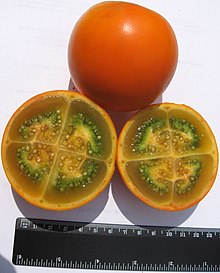Solanum quitoense, known as naranjilla (Spanish pronunciation: [naɾaŋˈxiʎa], "little orange") in Ecuador and as lulo ([ˈlulo], from Quechua) in Colombia, is a subtropical perennial plant from northwestern South America. The specific name for this species of nightshade means "from Quito."
The naranjilla plant is attractive, with large heart-shaped leaves up to 45 cm in length. The leaves and stems of the plant are covered in short purple hairs. Naranjilla are delicate plants and must be protected from strong winds and direct sunlight. They grow best in partial shade.
The fruit has a citrus flavour, sometimes described as a combination of rhubarb and lime. The juice of the naranjilla is green and is often used as a drink.holaaa !!
We´re working hard and teaching a lot, and a few of our investigators are progressing. Mostly the references...Contacting seems a lot ´cooler´, for want of a better word, but it´s just not that effective. Lots of people here like to éscuchar la palabra´, but few are willing to keep commitments of any kind and fewer will actually come to church. Still, we have found several really awesome families through just talking to people in the street, so it´s not like it´s pointless.
My companion and I are getting along well, and I´m learning how to direct. My Spanish gets in the way sometimes, but it´s getting easier to understand people.
José, the drunk guy in the street, is awesome. He and his not-quite-spouse are trying to quit drinking and are doing well. They didn't come to church this week because they were out of town, but the have a real desire to change and we have high hopes for them. They´re really just awesome people.
No new jugos this week...I had mango a couple times and maracuyá, and I made guanabana con leche in the house. Oh! I made jugo de lulo as well. I guess it´s kinda like a lemon, but I didn´t know that so I made the jugo with milk. Bad idea...it didn´t curdle the milk like a lemon would have, but it tasted like limonade made with milk, and was probably a waste of good lulo pulp. I don´t even know what a lulo looks like, I just bought a bag of pulp to try.
Other food stories...I ate probably the nastiest thing I've eaten in my life this week. They said it was some kind of candy made from papaya...basically it was like eating a big bowl of hot, chunky jelly. I felt terrible afterwards but I didn't throw up. I hope I never have to eat it again...it was my companion's first time eating it so maybe I'll be lucky.
Things are going well. I´m not totally comfortable yet, but I´m starting to enjoy missionary work a lot more and I feel like I´m improving. Life as a missionary is strange, but not bad. Felicidades to Garrett on the proposal...crazy! It's weird to think of him being married, and for a year and a half by the time that I get back. I'm the last one left.... o.O
Elder Coffman


This fruit is sometimes referred to as Cherimoya, Custard Apple, or Sweetsop. It is thought to have been introduced to South East Asia by the Spaniards, and is now cultivated in the West Indies, Bali, the Philippines, and tropical South America.
At time of harvest, the guanabana skin is deep green in color, with small, soft spines covering the surface, along with geometric scallop grooves. When ripe, the fruit turns greenish yellow and becomes much softer. Small brown seeds sprinkled throughout the white juicy flesh, combine to provide a somewhat cottony texture and highly aromatic vanilla like flavor. This fruit is growing increasingly popular, as trends in the tropical arena are now discovering the easy blending advantages of Guanabana.
| Widely used in juice drinks, beverages, baked goods, cereals, yogurt and ice cream |

the fruit pics and discriptions are great Mom.
ReplyDelete